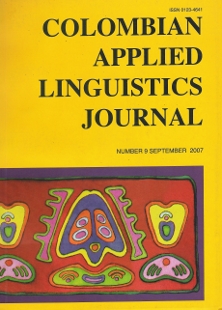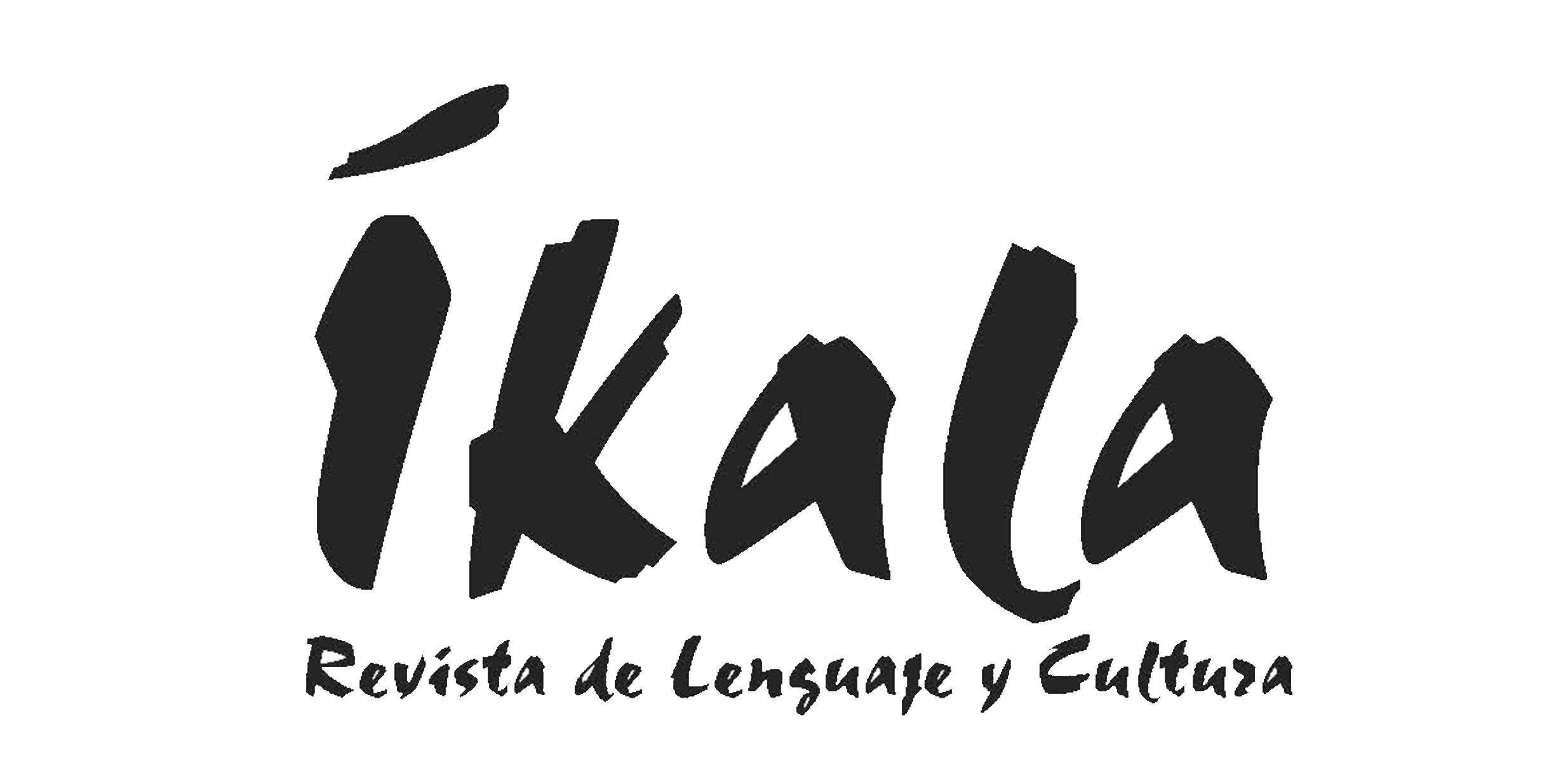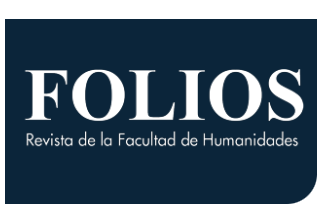DOI:
https://doi.org/10.14483/22487085.3146Published:
2007-01-01Issue:
No 9, (2007)Section:
Research ArticlesIntertextuality as resource for building ELLs generic competence: a systemic functional linguistic view
Keywords:
Estudiantes de Inglés como segunda lengua, Escuela primaria, Intertextualidad, Análisis Crítico del Discurso, Lingüística Sistémica Funcional, Géneros Literarios, Textos Informativos (es).Keywords:
English Language Learners, Elementary School, Intertextuality, Critical Discourse Analysis, Systemic Functional Linguistics, Genre, Informational Texts (en).Downloads
How to Cite
APA
ACM
ACS
ABNT
Chicago
Harvard
IEEE
MLA
Turabian
Vancouver
Download Citation
Editorial
Colombian Applied Linguistics Journal, 2007-09-00 vol:9 nro:1 pág:69-98
Intertextuality as Resource for Building ELLs Generic Competence: A Systemic Functional Linguistic View
Joshua Schulze - J. Andrés Ramírez
Abstract
This research examines how elementary English language learners(ELLs) used intertextuality as a resource to compose informational texts. The research examines ELLs’ use of intertextuality (Fairclough, 1992, 2003; Lancia, 1997) as a resource for developing generic competence (Bhatia, 2002). Using the tools of critical discourse analysis (CDA) and systemic functional linguistics (SFL), the researchers locate instances of manifest intertextuality to evaluate the extent of reliance on intertextual resources. While findings suggest strong reliance on intertextual resources and thus the potential to see this appropriation as a form of “transgressive intertextuality” (Pennycook, 2004), the close SFL analysis revealed that students’ grammatical moves to make the text their own have the potential to increase their linguistic control over the target genre of informational text.
Key words: English Language Learners, Elementary School, Intertextuality, Critical Discourse Analysis, Systemic Functional Linguistics, Genre, Informational Texts.
Resumen
Esta investigación examina la manera como estudiantes de inglés como segunda lengua (ELLs por sus siglas en inglés) utilizaron la intertextualidad como recurso lingüístico para elaborar textos informativos. Esta investigación analiza la utilización de la intertextualidad (Fairclough, 1992, 2003; Lancia, 1997) como recurso lingüístico en el desarrollo de competencia genérica (Bhatia, 2002). Haciendo uso de algunas herramientas del análisis crítico del discurso (CDA por sus siglas en inglés) y lingüística sistémica funcional (SFL también por sus siglas en inglés), los investigadores muestran evidencia del uso de intertextualidad manifiesta y de préstamo discursivo en los textos analizados con el fin de evaluar la importancia e incidencia del uso de estos recursos intertextuales. A pesar de que los resultados sugieren una dependencia amplia en recursos intertextuales y por ende la posibilidad de ver esta dependencia como una forma de “intertextualidad transgresiva” (Pennycook, 2004) asociada con plagio, el análisis detallado del discurso reveló que los movimientos gramaticales hechos por los estudiantes para ‘apropiarse del texto” tienen el potencial de incrementar su control lingüístico sobre el género discursivo de textos informativos.
Palabras Claves: Estudiantes de Inglés como segunda lengua, Escuela primaria, Intertextualidad, Análisis Crítico del Discurso, Lingüística Sistémica Funcional, Géneros Literarios, Textos Informativos.
Introduction and Problem Macro context
As English language learners (ELLs) enroll in US primary schools and begin developing English proficiency, they are expected to reproduce features of a variety of academic genres both on high-stakes tests and in classroom writing activities. The tests are considered high-stakes in nature because students may be retained and schools may be sanctioned if students do not meet performance standards as required by the No Child Left Behind (NCLB) legislation. With students and schools facing such dire consequences, stakeholders in these public schools look not only to educational research for information about writing instruction which helps them meet the needs of their ELLs, but also with increased frequency, to practices that focus almost exclusively on test results without measuring the possible negative consequences.
The almost exclusive focus on test scores requires that students embrace a frail culture of achievement built upon extrinsic motivations (prizes, points, and even cash ) which in the long run pose the threat of extinction of intrinsic motivations to learn once the rewards are withdrawn (Cameron & Pierce, 1994). This “soft bigotry of low expectations ” (ironically one of President Bush’s principal educational slogans to promote standardized testing) ends up being a disservice to all students, but especially to linguistically and culturally diverse ones who in the US have long carried the stigma of not performing at desired levels. Such critique of current educational reform in the US stems from a broader project associated with critical social research. Critical Discourse Analysis (CDA) is the approach to critical social research that the researchers in this article favor; one that focuses its inquiry on questions of power, ideology and hegemony through a recursive exploration of text and context (e.g., local, institutional and societal domains) and sees language as realization of ideology and as an irreducible part of social life (Fairclough, 2003).
As such, analysis of language within CDA incorporates analysis of the ideology specific texts evoke either through assumptions or relations with other texts (ibid, p. 39-41). SFL is the preferred tool used in this article for linguistic analysis. While the researchers’ enduring purpose is to help move the linguistic field into a domain of social and political relevance by providing a social critique which documents structures of inequality, broader issues dealing with power and structures of inequality are not explored in detail in this article. Rather, the main concern in this article is twofold. First, researchers intend to uncover instances of manifest intertextuality and literary borrowing evident in the focal students’ informational reports. Second, they make claims concerning students’ use of these resources to construct an understanding of genre practices and recontextualize intertextuality as socially mediated rather than as an individual practice.
A brief look at narrative research is given as background to begin to address these two issues. Prior research has shown the over reliance and disproportionate attention that narrative genre traditionally receives in primary school (Kamberelis, 1999). This is so despite the fact that students are expected to engage with informational texts both in school and out. Hoping to shift focus away from narrative genres, this research focuses on one of the resources that ELLs use as they learn to write informational texts. In particular, the research examines how one group of ELLs receiving supplemental language arts instruction in an urban elementary classroom in the northeast of the United States uses intertextual resources in their composition of informational reports.
To meet the needs of a large population of ELLs, the school district in which this research takes place has adopted a genre-based approach to writing instruction . This framework has been adopted district wide and all teachers are recommended to implement lessons which mirror this approach. By genrebased, we mean the approach most associated with Australian SFL researchers or the “Sydney School” (F. Christie, J. Rothery, J. Martin) which “privileges language and text as a system delivered through networks and structures over the individual, dynamic, performative aspects of language encounters” (Knapp and Watkins, 2005, pg. 22). The model focuses on the social purpose of texts and the stages a text goes through to realize this purpose.
Micro context
This research looks at three (3) ELLs in one such ESL (English as a Second Language) classroom and the resources they use to write informational reports. This classroom is a fourth grade ELL group in an urban elementary school that has a nearly sixty-percent Latino population. Of that sixty percent, twenty percent are labeled English language learners (according to the district report card). Since bilingual education was eliminated by voter proposition in the state where this research takes place, ELL students receive supplemental language arts support with native language instruction limited to use for “clarification purposes” only. The three participants in this study are all receiving such supplemental instruction.
The classroom teacher, Marybeth identifies herself as a white, middleclass, woman in her forties. She has been teaching at Bollinger Elementary for fifteen years; however, this is her first year as an ELL teacher. The students are all native Spanish speakers. Two of the students identify themselves as being of Puerto Rican descent with one born on the US mainland. The other student was born in Colombia. Each has been enrolled in the district school for over one academic year.
Theoretical Framework
The theoretical perspective informing this study is the concept of intertextuality (Kristeva, 1986) fairly used by discourse analysts (see Fairclough, 1992, 2003 for CDA; and Lemke, 1995 for social semiotics). Kristeva (1986) first used this term to articulate the notions of the Russian linguist Bahktin who theorized that language, both oral and written, is composed of responses to previous texts and anticipations of future ones (Bahktin, 1981,1986). Fairclough further noted that “All utterances (or what he called texts) are populated, and indeed constituted by snatches of other’s utterances, more or less explicit or complete.” (Fairclough, 1992, pg. 102). For example, the students’ informational texts analyzed exemplify intertextuality as these texts reproduce structural and content features from the websites students used as resource. As it becomes clear in the analysis, students choose to reword or borrow ideas for clarification, but nevertheless the ideas do not originate with the authors. Furthermore, these ideas may not even originate with the person to whom they are attributed. Rather they echo the ideas and words of others who wrote before them.
In other words (and how that expression takes on new meaning in this context), intertextuality re-voices that which has been said over and over again creating what Fairclough viewed as a “chain” of linked utterances which may be horizontal or vertical (Fairclough, 1992, pg. 130). Horizontal intertextuality occurs when an utterance is made in direct response to another as in turn taking in a conversation or response to a note or as in an instructor’s comments made on an academic paper. Fairclough characterizes vertical intertextuality as “historically linked with in various time-scales an along various parameters, including texts which are more or less contemporary with it” (Fairclough, 1992, 103). Thus, the concept is one of texts or utterances building one upon the other. This research focuses primarily on this form of intertextuality as it examines instances in which students appropriate texts to make them their own and articulate their ideas in their own texts.
In adherence with common academic practice, the authors of this study attribute those ideas which are not their own to the source from which they have been appropriated. Attributions are indicated by placing the utterance within quotation marks or with citations. Fairclough explains that these marked features denote “manifest intertextuality” (1992, p. 104). Manifest intertextuality may take two forms. In the first form, the directly borrowed words are placed in quotation marks (or not) and may be evident in the writer or speaker’s wording of his/her response to an utterance or text. The other form of manifest intertextuality Fairclough mentions is “constitutive intertextuality (ibid, 104)” which he defines as “the configuration of discourse conventions” that go into text production (ibid, 104).
The discourse conventions favored by the academy require authors to use quotations to indicate manifest intertextuality. If they are not employed, the author faces charges of plagiarism defined by Merriam-Webster as “stealing and passing off one’s ideas or words as one’s own.” Thus, plagiarism is associated with criminal activity in ways in which other errors made by ELLs are not (Chandrosoma et al, 2004). Pennycook argues that the idea of ownership is a Western thought (Pennycook, 1996). If the idea of seeing texts as socially constructed, as being populated by other snatches of sentences, applies to how scholars and others build their texts, the same should be true for ELLs as they compose informational reports.
According to Knapp and Watkins (2005), informational reports contain distinct grammatical and structural features. The grammatical features most associated with the informational report genre include predominant use of the following: present tense, relational processes (i.e. linking verbs) to classify and describe functions of phenomena, adverbial phrases to add information, technical adjectives, thematic links to topic of description, and a focus on classes of things as opposed to the individual. The structural features most associated with this genre include but are not limited to classification, description of object properties and appearance, and assignment of attributes such as behavior and function (See Knapp & Watkins, 2005, p. 105).
The previous characterization of informational texts corresponds to how genre-based pedagogy (associated with the “Sydney School” already referenced above) relies on the theoretical and methodological tools of SFL which stresses the ever present social character of texts. In other words, language is structured as it is because of the function it performs and not because of the established grammar rules. Because both CDA and SFL “emphasize the cultural and historical aspects of meaning” (Graham, 2004) they are concerned with similar issues. However, each of these approaches can complement each other or can be carried out by focusing more on certain aspects of meaning formation. Mostly because of space constraints in this article, the researchers prioritize a SFL analysis over a CDA one.
Keeping in mind the CDA/SFL theory-method linkage, this research uses SFL to analyze how students build their focal texts. Within the SFL tradition, language is a system of meaning potential (Eggins, 1994; Halliday, 1994) As such, SFL gives priority to the paradigmatic relations in language (that is to the choices) and thus allows us to ask why, out of so many choices (paradigms), did a speaker make that choice and not another. Language as a system of choice has infinite combinations; however, because meaning is always situated and context-bound, such choices are always made finite and are regulated by ideology, genre, and register. Building on the concept of ‘existential paradigms’ put forward by David Brazil, Michael McCarthy writes “In real situations, the selection of an item may be from only a small range of plausible alternatives or indeed may not represent a real choice at all” (McCarthy, 1998 p.70). This view of language, espoused by many critical social researchers, is instrumental in challenging prescriptive and ideal notions of what is correct or not as it may allow us to consider sociocultural variables (i.e., class, race, gender) that come into play when assigning value to certain linguistic choices over others.
More specifically, SFL looks at language basically as a semiotic system in which meaning is made based on choices regulated by a) ideological assumptions (the values we hold, the biases we adopt), b) the genre or context of culture (the staged, purposeful way in which people go about achieving purposes using language in a culture), and c) the register or context of situation. Register variables include the field, that is, the topic talked about and the way the world is represented; the tenor, the role relations that the text enacts between those involved; and the mode, the medium used to pass on the message. These three register variables correspond to the three metafunctions of language called ideational, interpersonal, and textual.
These three levels are called in different ways by different people. Lemke for example calls them Presentational, Orientational, and Organizational (Lemke, 1995). Fairclough calls them ways of acting, representing and being (Fairclough 2003). These are all generalizations from Halliday’s (1994) analysis of the meaning functions of the English clause -ideational, interpersonal, and textual (Halliday, 1994; Halliday & Hasan, 1976).
The important point here is that all meaning-making, including linguistic meaning-making, necessarily simultaneously makes these three kinds of meaning. The simultaneous presence of each of these meanings in any text is necessary if anyone is to make sense of each other and the world around them. The diagram below attempts to provide a graphic representation of how SFL conceives language as a semiotic system regulated by ideology, genre, and register features. What may seem to be abstract and somehow complicated is further simplified as the graphic uses a text concerned with a recipe to make arepas. The recipe is followed by the graphic representing it.
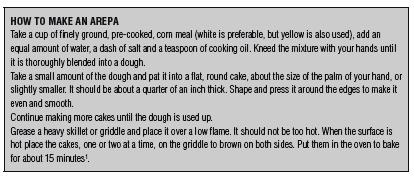
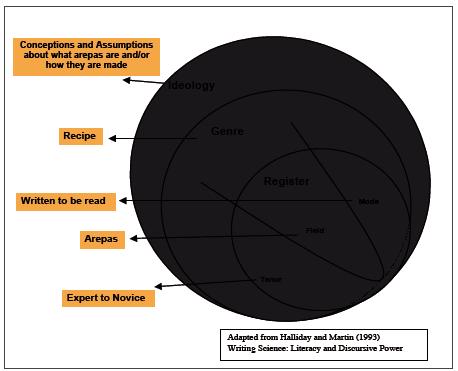
Choices at the ideology, genre, and register level result in the arepas recipe reproduced above. The author of the text above has a particular view of what arepas are and how they are prepared. S/he refers to arepas as “the local equivalent of a hamburger”. S/he has a particular way of preparing them which may not conform with how arepas are made elsewhere. These choices represent the level of ideology. At the genre level, the text conforms to the genre of procedural recounts as it takes the form of recipes. This kind of text typically lists individual ingredients first and then directs the reader in a logical sequence.
Experiential, interpersonal, and textual meanings are represented by field, tenor, and mode respectively and make up the register variables. Arepas as the focus topic realizes the field of the text (its ideational meaning) which is further stressed by the presence of lexical items that concern the topic (i.e., dough, corn meal, sides). The arepas recipe supposes a writer who is knowledgeable and a reader who is novice. These power relationships are built in within the lexicogrammatical choices of the text realized by the prevalence of the imperative mood (take, kneed, shape, grease). It is in this way that interpersonal resources enact our social roles and relations between participants in texts. If two people who did not know how to make arepas were together trying to prepare them from memory from some Colombian or Venezuelan party at which they were some time ago, we can predict that they would use a lot of interrogative mood between them (How much water should we use with the corn meal?).
Finally, the arepas recipe expresses textual meaning (discourse) structured in such a way that brings to the fore actions to be performed in a logical sequence (imagine if you were to place the corn meal in the heavy skillet or griddle before mixing it up with water!). Textual resources organize the other two kinds of meanings (ideational and interpersonal) as a ‘flow of information that is possible for listeners and readers to process’ (Butt et al. 2004).
Methodology
Data Collection
This research stemmed from a larger ethnographic study in which the researchers spent a year observing the literacy practices of this ELL group. For this part of the study, researchers observed ten lessons each lasting approximately two hours in duration. In these observed lessons, students read two books. Marybeth also guided the students to a series of websites related to phenomena of nature and weather which they were to use as resources for their text compositions. One was a sample of realistic fiction depicting characters involved in weather disasters and the other was described as “a non-fiction companion” to this text. Data collection methods included the researchers taking field notes, collecting student’s notes and work samples as well as the classroom texts, and downloading the websites students used as reference points for their own research. These websites served as the primary resource for student’s literary borrowing and manifest intertextuality that are the focus of this paper. The writing samples which the researchers used for analysis were the product of an assignment in which the teacher asked the students to choose one phenomenon of nature and write an informational report describing it. The students chose blizzards, tornadoes, and tsunamis, respectively.
Data Analysis
Three student texts were available for analysis (See Appendix 1). To analyze the texts the researchers first consulted their field notes and identified the sources used by the students to compose their texts. The primary sources were identified as websites (See Website Resources). These websites were downloaded for researcher analysis.
Next, the researchers read each of the texts and the websites and made a preliminary identification of instances of overt intertextuality or what appeared to be chunks of student text which shared similarities with website content. These chunks of texts were composed of full length sentences, phrases, and vocabulary. To organize the data visually these examples were placed on a chart alongside their suspected source (See Appendix 2).
Then, to provide a deeper illumination of the intertextuality in the student’s text, the researchers first conducted a genre analysis of the text and then moved to analyzing the text according to the three metafunctions of systemic functional linguistics (Halliday and Matthiessen, 2004; Thompson, 2004) already detailed.
Research questions
The purpose of this study is to analyze students’ informational genre texts to uncover instances of intertextuality. The questions guiding this study are:
- How do the students’ texts demonstrate intertextuality in terms of the experiential, interpersonal, and textual metafunctions?
- How does the students’ use of intertextuality help students to write informational reports?
Findings
Before proceeding with the findings, it is worth noting that some elements in the text will be mentioned more than once. This is so because of the importance of these elements in the text, but mostly because of the simultaneous meanings they make and the need to analyze them recursively.
>Genre Analysis
Genre analysis of the students’ texts revealed that the ELLs first used intertextuality as a resource for generic competence as they appropriated the generic structure of the target text, in this case an informational report from a website, when composing their own texts. For Systemic Functional linguists genre represents “staged, goal oriented, social processes” (Martin, 1993) with each genre taking a structural formation composed of stages. Each stage performs different functions and moves in these stages are signaled by the presence of different processes (verbs) (Eggins, 1994).
The first paragraph of an informational report typically introduces the report’s topic by making a general statement of classification or definition. This stage is signaled by the author’s use of relational processes which function to define and classify. To identify how the ELL students were appropriating the generic structure researchers examined their texts to compare each paragraph to see if they mirrored each and had similar functions. They identified instances in which functions shifted and noted the process change that accompanied these functional shifts.
Comparison of the target and students’ texts revealed the students’ generic appropriation as evidenced by structural as well as linguistic features particular to the target genre. Table 1 compares the opening statements found in the first paragraphs of the target text and the students’ texts.

In the first example, the student’s text mirrors the target text structure in that it introduces the topic in its classification stage. This is done by using generalized participants, (i.e.) Tsunami and employing the relational process “is” to define this generalized participant. This relational process “is” remains in the timeless present, a typical linguistic feature of the genre.
Typically, as informational reports progress through their structural stages, paragraphs serve different functions. The ensuing paragraphs often describe the appearance and behavior of the topic (Derewianka, 1990; Knapp and Watkins, 2005) through the combination of relational and material processes. Further comparison of these texts reveals how the students continued their generic structural appropriation as their own texts progressed. In Table 2 the reader will see how the students describe the behavior of their chosen topics.
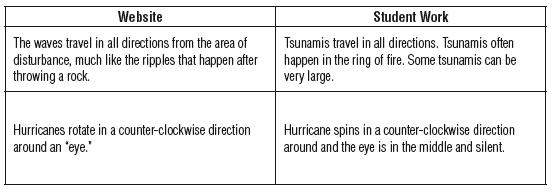
The first example which comes from the student’s second paragraph shows how the student’s text has progressed in generic structure as the paragraph functions to describe the behavior of the tsunami. In this instance, the student begins to use material processes, in this case relying on manifest intertextuality to appropriate the material process, “travel” from the original text. In the second example, the student alters the material process from “rotate” to “spins”, maintaining the meaning and the material process form, but changing the lexical item. In the student’s text, however, the function remains the same, as both texts describe the behavior of the hurricane.
Evidence of additional reliance on intertextuality is evident in appropriations of other linguistic features. For example, the student also chooses to appropriate the adjunct “counter-clockwise” from the target text. This term is representative of the technical vocabulary which categorizes the informational report genre. A certain level of lexical sophistication-required in the genre-is evident in this particular appropriation.
As each of the student’s text progressed, the researchers noted that the student texts followed the generic structural form. Students’ next paragraphs functioned to describe the appearance of their chosen topic. Table 3 shows how they appropriated this structure to allow the paragraph to function as a description of the topic’s appearance.

Here the student again uses the relational process “is” to describe the appearance of her topic, in this case a hurricane. Using the relational process strengthens the students work as it allows her to add factual and precise details describing the hurricane’s appearance.
Genre analysis of the texts reveals that English Language Learners benefit from and use the available texts as intertextual resources. They appropriate not only the information of the original text as in literary borrowing (Lancia, 1997), but also the generic features belonging to the “pedagogic reservoir” as tools to develop control over textual resources to develop their own “pedagogic repertoire”, and thus, make the text their own . While this kind of appropriation is overt and manifest, it is worth noting that such actions are not penalized, but rather are encouraged in materials using a genre based approach as their explicit inclusion as part of daily lessons have been demonstrated to increase students’ control over generic features of target genres (Christie, 2002; Hasan & Williams, 1996; Schleppegrell, 2004; Schleppegrell & Colombi, 2002).
Experiential Analysis
The experiential analysis of the instances of manifest intertextuality in the students’ writing revealed how students were appropriating and using the content of the internet sources (how they represent the world) to compose their own informational genre texts. To analyze the text experientially, the research examined student appropriation of participants and processes which are two of the main resources to express experiential meanings. The findings reveal that throughout all three samples of the students’ texts, participants remained largely unchanged in the instances of manifest intertextuality. Table 4 shows how one student appropriated the participants from the website without any change in her own text. “A hurricane” or “hurricanes” remains the participant in both her sentences. One instance of participant change occurs, however, when the student employs a “denominalization.” This term describes the opposite of the procedure of nominalization. This denominalization occurs during the expansion of the nominalization “Evaporation” to “The water evaporates.” Appropriation of the nominalization would reflect a greater level of lexical sophistication in the informational report genre, but the writer chooses not only not to appropriate this form, but to denominalize it. This ‘unpacked’ nominalization achieved through the transformation of the nominalization “evaporation” into the less ‘packed’ expression “the water evaporates” is more typical of oral genres (Eggins & Slade, 1997). Because in this case the focal English language learners are less familiar with written genres such as the informational report than with oral genres such as discussing, this ‘denominalization’ can be interpreted as the students attempting to make the text their own. A different but related simplification strategy can be seen as the student in this case chooses not to rename the participant as the original text does in “the center of the storm or the eye.” Instead she simplifies the participant to “the eye” and locates the eye “in the middle” which again is a way of breaking up the nominalization or denominalizing “the center.” Table 4 provides a snapshot of these changes.
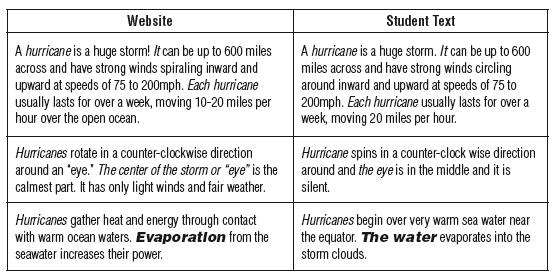
There are other examples among the students’ writing that demonstrates alterations of processes. For example, the following clause reflects changes.

Notice the changes. First, the student changes the material process “rotates” to “spins.” As already stated, both are material processes, but “spins” is arguably a less lexically sophisticated choice. When she chooses to use “spin” instead of “rotate” she makes her own voice apparent in her text. Perhaps this alteration reflects her having asked her teacher for a clarifying definition of the word “rotate” or she found the definition in a thesaurus. Either way, this lexical choice helps make the text her own as again, this lexical choice is less technical and thus more closely related to oral genres .
Additionally, when she changes “The center of the storm is the calmest part. It has only light winds and fair weather” to “the eye is in the middle and it is silent” she effectively collapses the ideas that are represented by two clauses in the website version into one. The ideas of “calmest”, “light winds” and “fair weather” become “is silent.” She maintains the use of the relational process “is” in both clauses but collapses the ideas represented in both into one clause in her own version.
There are other instances of process alteration but also process appropriation. The following table shows two examples:

In the first example, the student appropriates the material process “triggers” and alters it to a progressive material process “has been triggering.” In the second example, the student appropriates the material process “stuck.” This is a particularly interesting sample of intertextuality because the original text represents the narrative genre. The student’s text arguably looks more dense and technical despite the fact that the noun “blizzards” in the original text is denominalized into the less packed expression “roads get filled with snow.” This example is interesting because it shows how the student perceived that a shift from the narrative characteristics of the passage in the original text to those of an informational report was needed. Such a shift may be an indication that intertextual appropriations across genres are beginning to populate students’ texts.
Interpersonal Analysis
An interpersonal analysis of the intertextuality in the students’ texts showed how students utilized the website resources to establish communication and interact with their readers. As mentioned previously, the purpose of their assignment was to describe a weather phenomenon. Thus, in Hallidaian terms, they are “giving information” and the “goods and services” they appropriate from the website sources represent this function (Halliday & Matthiesen, 2003; Thompson, 2004).
Looking first at the basic speech roles (or in this case written text roles) of the intertextual references, findings reveal that students did not change any of these basic roles when they made intertextual appropriations. The following table compares roles.

Comparison of the roles reveals that the function of the students’ clauses remained “information giving” in their texts. Additionally, most of the intertextual samples maintained their grammatical structure as declarative clauses. The third example (and Table 8) shows some alteration of this grammatical structure, however. Here the student picks up the experiential content of “layers” and appropriates the material process “wear” but deletes the “wh-element” in “What their mother meant was” and instead uses the imperative form “Wear outer garments.” Again, this textual analysis of the intertextuality shows how the student alters the grammatical structure as she converts the narrative genre source into one that more closely resembles an informational report.

The interpersonal analysis of the texts also focused on modality use. The modality resources of language help writers assess the validity of their text (Thompson, 2004). When students use a high level of modality, adding “may, should, could, can, might” and other modals they adjust the strength of the validity of their claims. Using weak modals such as “could” or “might” indicates a weaker claim. In the student texts some instances of modality remained unchanged as students employed manifest intertextuality to appropriate the modality in its exact form. Table 9 shows examples of this modality maintenance

In both these instances the student uses manifest intertextuality and maintains the modality in its exact form in their texts. However, interpersonal analysis also revealed instances of modality loss.

In the first example, the student did not appropriate the modality of frequency “About four out of five” as a modifier of tsunami and chooses to pack this information into the adjunct “often.” In the second example, the student eliminates the modal “can” in “can race” and chooses another material process and participant “water moves.” In the third example, the modal adjunct “only” is not taken up, and lastly in the fourth example the student does not take up the modality of probability evident in “could get stuck” and instead chooses “cars get stuck.”
Lastly, the research revealed that levels of appraisal (the language of attitude10) were also maintained throughout instances of intertextuality in student work. The lexical choices expressing attitude often remained the same and did not indicate any appraisal shift. The research reveals only one example of this appraisal shift in the student texts.

Comparison of these two clauses reveals that the student chose not to maintain appraisal inherent in the clause “To save lives” which expresses a socially sensitive attitude toward the warning system. Her choice to use the word “scientists” without this appraisal marker denotes a more “scientific” and “objective” stance typical of information reports.
To conclude, the interpersonal analysis of the text revealed that students used modality in several instances to construct informational text genres. They may appropriate it in its exact form as in manifest intertextuality or they may respond to it using similar discursive formations or use varying levels of appraisal. Whatever way they choose to engage with modality, they are using it in their informational texts, nevertheless.
Textual Analysis
Textual analysis of the intertextuality in student texts revealed how students used the resources to construct a message within the context of the informational report genre. Findings revealed that they did this primarily through appropriation of the theme and rheme. Systemic functional linguists equate theme with the new information introduced in an utterance. Rheme is the information which has been previously introduced. Generally, the theme is equated with the subject of the sentence and in this instance considered unmarked (Halliday and Matthiesen, 2003; Thompson, 2004).
In cases of manifest intertextuality, the students simply appropriated the theme unchanged and in its entirety. In these cases however, they still may have altered the rheme. The following table exemplifies one student’s unmarked theme appropriation and rheme alteration.

Textual analysis reveals, however, that in other cases students “picked up” the theme but they did not replicate it exactly. Table 13 shows how instances in which the subjects (in traditional grammar) remained the same, but the theme was altered.

In the first example, the student does not use the reference pronoun “they” as theme, but rather uses the more concrete theme “Hurricanes” in her text. In addition to it being more concrete, the theme “Hurricanes” is also an unmarked one in contrast to the marked theme “When they come onto land” used on the website. This choice is less an indication of the student’s lack of control over the use of unmarked themes and more a strategy to make the text her own. Additionally, it indicates the student’s ability to conform to target features of the informational report genre. Plenty of evidence that this is the case follows.
In the second example, the student adds “the word” before tsunami, perhaps as a manner of theme clarification. The third example shows how the student picks up the theme from the narrative genre example and changes it from the “he”-which is a reference to a character in the narrative-to “Blizzards” which is a topical theme and the subject of her report. She is making (these researchers term) an “intergeneric” theme alteration. By this it is meant that she demonstrates how themes are appropriated through intertextuality to fit the linguistic requirements of a different genre- in this case the genre of informational texts.
Another instance of theme alteration occurs in the tsunami report. Table 14 below shows the original website report, the student’s use of the participant during the intermediary drafting stage, and her final report.

On the website, “Tsunami” serves as the theme or point of departure of the sentence. While the student chooses to maintain “tsunami” as theme in her draft, she changes the goal from “people” to “many lives.” Her final report shows a significant change in that “Tsunami” no longer functions as the unmarked theme (usually a subject), but rather as the point of departure of the clause is “More than 50,000 people.” This change reflects transition from the unmarked themes “Tsunamis” into a marked form that shows a great deal of agency and thus greater linguistic control on the part of the student. This sophistication is evidenced as “Tsunami” no longer remains responsible for the killing, and an ellipsis occurs as the expected adjunct clause “by Tsunami” does not appear in the sentence. That is, this change does not simply reflect an alteration of the processes among the sentences. As “Tsunami” no longer appears as the actor participant in the final version, and the agency shifts, the student employs a passive clause formation to emphasize that agency omission. The clauses changes from “(Tsunamis) have killed” to “(People) have been killed.”
The last part of this section will briefly look at textual cohesion. One of the ways textual cohesion (or lack thereof) is demonstrated is through reference.
Reference is an additional element of the textual metafunction which concerns the manner in which the speaker or writer repeats information which is already shared by the participants or whether he introduces something new in the text (Thompson, 2004). Ellipsis and substitution serve as the two main points of reference in a text. An ellipsis occurs when there is an avoidance of repetition of previously known information. Substitution occurs when that information is replaced with a “linguistic token” (Thompson 2004, pg. 180) such as “so” to stand in place of the information. Table 15 compares reference use in the website and the student text.

The website creates coherence by using “this” which Thompson (2004) classifies as an endophoric reference. The student text does not do so. This absence of endophoric reference reveals a lack of textual sophistication. The writer is yet to demonstrate this technique in her writing, and this certainly has implications for writing instruction. The students writing will likely be improved when the instructor addresses the use of endophoric references.
Textual analysis revealed that while students were not always able to achieve a consistent level of textual sophistication and appropriation to make their text cohesive, they utilized many more strategies that speak of their ability to learn from intertextual resources.
Conclusion and Implications
Findings revealed by this research have implications for both the teacher and researcher of ELL writing. For EFL and ESL writing teachers, the research reveals students’ use of intertextuality and how their use of intertextuality supported their construction of the practices associated with the informational text genre. That is, they use the resources available to them to appropriate chunks of language which support their development of the target genre. These appropriations may come in the form of literary borrowing in which the information is transferred from a source to target text or as manifest intertextuality. Some teachers may see this appropriation of language as a form of “transgressive intertextuality” (Pennycook, 2004) that is viewed as possible plagiarism and discouraged as a practice. However, this research shows that although students may use manifest intertextuality, they often alter theme or material process or other language functions not only to make the text their own, but to conform to the social expectations of the target genre. EFL and ESL writing teachers who are interested in promoting the composition of informational texts in their classrooms will want to note that their ELLs use intertextual resources as tools for building generic competence in the composition of informational reports.
Furthermore, in the era of “high stakes education” (Lipman, 2004), administrators and EFL/ESL teachers should note that they are not the only ones under great pressure to perform. Students, especially those whose control of the English language is emergent and whose writing test scores are lower might be pressured more than ever before and more than their native speaking peers to rely on texts traditionally detached from their own “lived experiences.” They may even resort to using tools that are perceived as inappropriate as in the case of “transgressive intertextuality.” Under these circumstances, it is clear that students’ intertextual practices not only respond to individual choices, but to socially mediated dynamics. However, as this research shows intertextuality is used as a meaning making resource which students strategically apply by intentionally leaving pieces of the original text untouched or by modifying them hoping to conform to expectations. When an unnecessary emphasis is put on test scores, students’ strategies should not be criminalized, but rather encouraged. Instruction of genre features, language they trigger, and the possibilities and ethical paradoxes of using intertextuality as a resource should be explicitly taught and not left for students to figure out on their own. Such an approach specifies some features of what a critical literacy framework should espouse.
This research also has implications for critical language researchers as it serves as an example of how they can analyze the linguistic metafunctions of student text to reveal levels of intertextuality and the ideas focal texts foreground or silence. Once these intertextual links are made visible, and their value systems recognized, researchers may make claims about the value of having certain resources available to linguistically diverse writing students. For example, in this research, students used websites as content and structural resources for their informational reports. Upon closer analysis that will be explored in later work, the researchers found that the websites used language strategically to ensure particular interpretations. Specifically, the websites (see website sources) construct disaster preparedness as a responsibility of the individual or the family and not as an endeavor in which the government should play a crucial role. In case of a warning, one website recommends, “your family should be in the process of completing protective actions and deciding the safest locations to be during the storm”.
Another website designed specifically for children by FEMA, the federal emergency system in the US, advises those in the hurricane’s path to “make sure there is gas in the car, and you are ready to evacuate immediately if you are told to do so”. Both of these websites place the responsibility of action on the potential hurricane victim without mentioning any factors which may prevent these actions from occurring. Additionally, they make assumptions about the options available to those affected by the hurricane. They assume all those affected by the hurricane have an alternative place to take shelter or have the money to put gas on their car, or have a car for that matter. These assumptions were proved dreadfully inaccurate as evidenced by the ensuing disaster of Hurricane Katrina in New Orleans. There, hurricane victims too poor to leave their homes and possessions were drowned in their own homes as levees broke and inundated the 9th ward of New Orleans.
It is our hope that the analysis provided and issues raised in this article will contribute in some ways in relating texts with the worlds they seek to construct and realities they inadvertently (or not) seek to hide.
Questions for further research
Further research on the use of intertextuality in ELL students’ text would be beneficial to understand how these ELLs are using intertextuality as a resource to construct a variety of genre practices. Questions related to this particular research include:
- 1. How is this intertextuality perceived by the teacher? Does she view it as tool (As a tool for language development and a form of non-transgressive intertextuality) or rather, as a form of transgressive intertextuality (Pennycook, 2004) which borders on plagiarism?
- 2. What are the socio political educational contexts influencing students use of intertextuality?
- 3. How can schools which already enjoy Internet access ensure students critically engage these texts?
- 4. How do common curricular materials used in schools (i.e., websites) use language to ensure particular interpretations and reproduce current dominant class structures?
References
Bakhtin, M.M. (1986) Speech genres and other late essays (V.W. McGee, Trans.) Austin: University of Texas Press.
Bakhtin, M.M. (1981) The dialogic imagination: four essays by M.M. Bakhtin. M. Holquist, Ed; C. Emerson and M. Holquist, Trans.) Austin: University of Texas Press.
Bhatia, V.K. (2000) Integrating discursive competence and professional practice: a new challenge for esp. Paper presented at TESOL colloquium “Rethinking ESP for the New Century,” Vancouver, March, in B. Paltridge, Genre and the language learning classroom. Ann Arbor: University of Michigan Press.
Cameron, J., & Pierce, W. (1994). Reinforcement, Reward, and Intrinsic Motivation: A meta-analysis. Review of Educational Research, 64, 363-423.
Chandrasoma, R., Thompson, C. & Pennycook, A. (2004) Beyond plagiarism: transgressive and nontransgressive intertextuality. Journal of Language, Identity, and Education, 3 (3), 171-193.
Christie, F. (2002). Classroom discourse analysis : a functional perspective. London; New York: Continuum.
Derewianka, B. (2000). Exploring how texts work. Sydney: Primary English Teaching Association.
Eggins, S. (1994). An introduction to systemic functional linguistics. London: Pinter Publishers.
Eggins, S., & Slade, D. (1997). Analyzing Casual Conversation. London: Equinox.
Fairclough, N. (1992) Discourse and social change. Malden: Polity.
Fairclough, N. (2003). Analysing discourse : textual analysis for social research. London; New York: Routledge.
Halliday, M. (1994). An Introduction to Functional Grammar (2 ed.). New York: Routledge.
Halliday, M.A.K. (1996) Literacy and linguistics: a functional perspective. In R.Hasan and G. Williams, Literacy in Society. London and New York: Longman.
Halliday, M., & Hasan, R. (1976). Cohesion in English. London: Longman.
Halliday, M.K. & Matthiessen, C. (2004) An introduction to functional grammar. London: Hodder Arnold.
Hasan, R., & Williams, G. (1996). Literacy in society. London ; New York: Longman.
Kamberelis, G. (1999). Genre development and learning: children writing stories, science reports, and poems.Research in the Teaching of English, 33 (4), 403-459
Knapp, P. & Watkins, M. (2005) Genre, text, grammar: technologies for teaching and assessing writing. Sydney: University of New South Wales Press, Ltd.
Kristeva, J. (1986) Word, dialogue, and novel. In T. Moi (ed.), The Kristeva Reader, Oxford: Basil Blackwell, 34-61.
Lemke, J. (1995). Textual Politics: Dicourse and Social Dynamics. London: Taylor and Francis.
Lipman, P. (2004). High stakes education : inequality, globalization, and urban school reform. New York: RoutledgeFalmer.
McCarthy, M. (1998). Spoken language and applied linguistics. Cambridge, England ; New York, NY: Cambridge University Press.
Pennycook, A. (1996) Borrowing other’s words: text, ownership, memory, and plagiarism. TESOL Quarterly, 30 (2), 201-230.
Schleppegrell, M. (2004). The language of schooling : a functional linguistics perspective. Mahwah, N.J.: Lawrence Erlbaum.
Schleppegrell, M., & Colombi, C. (2002). Developing advanced literacy in first and second languages : meaning with power. Mahwah, N.J.: Lawrence Erlbaum Associates.
Thompson, G. (2004) Introducing Functional Grammar. London: Oxford University Press.
Website Sources
www.fema.gov.kids
www.national geographic.com/ngkids/9610/kwave
www.skydiary.com/kids
www.wildweather.com
www.weatherwizkids.com
Appendix 1: Student Texts
Text 1: Blizzards Are Here
- A blizzard is a storm with heavy snowfall, cold temperatures, and very strong winds.
- When there’s a blizzard it is really cold and trees fall in the street.
- Also streets get blocked and cars get struck and then it can’t move.
- A blizzard occurs when a cold air mass moves out of the Artic into the warm zone.
- The heavy cold air rises along the edge between two air masses.
- This edge or boundary is called a cold front.
- Blizzards affect the world because roads get filled with snow and then you can get stuck.
- If there is a blizzard you need a lot of moisture in the air.
- Also, you need to keep lots of layers of warm clothing handy.
- If you are going outside wear outer garments that are tightly.
- Also blizzards are very cold storms with lots of snow.
- A blizzard is almost like a snowstorm.
- If there is a blizzard you want to keep the house warm and cozy and especially safe by installing storm windows or cover the windows with plastic, insulate walls and attics, and apply caulk and weather stripping to the doors and windows.
Text 2: Never Live Near the Beach
- A tsunami is a giant wall of water.
- The word tsunami means great harbor wave in Japanese.
- Tsunamis are also called tidal waves.
- A tsunami can cause much damage.
- Tsunamis travel in all directors (sic).
- Tsunamis often happen in the ring of fire on the edges of the Pacific Ocean.
- Some tsunamis can be very large.
- The height can be as great as thirty feet or more.
- 100 feet in extreme.
- A giant jolt causes an earthquake.
- ‘Parts of the ocean floor’.(Sic)
- An earthquake has been triggering a tsumani.
13. The water moves 500 miles an hour going on both day and night through the ocean floor.
14. As the tsunami approaches the shore, it strikes.
15. More than 50,000 people have been killed in the past century.
16. Scientists established the Pacific warning system.
17. If you are in school and you hear a tsunami is coming, you should follow the teacher or other school personel.
18. ‘Tsuna mis can occur at any time of the day or night’.(Sic)
Text 3: Hurricanes in the United States
- A hurricane is a storm that causes great damage.
- Hurricane (sic) begin near the equator and have wind of 74 miles per hour or greater.
- At that point the hurricane is given a name like Hurricane Katrina.
- A hurricane is a huge storm.
- It can be up to 600 miles across and have strong winds circling around inward and upward at speeds of 75 to 200mph.
- Each hurricane usually lasts for over a week, moving 20 miles per hour.
- Hurricane spins in a counter-clockwise direction around and the eye is in the middle and it is silent.
- Hurricanes begin over very warm sea water near the equator.
- The water evaporates into the storm clouds.
- The warm, moist air rises to from thunder storm.
- The storm begins to spin and travel across the ocean.
- When a hurricane hits land, it slows down.
- Hurricane affects people because it spins around fast and it is dangerous and heavy.
- Hurricanes bring wind and rain and crush houses down.
Appendix 2: Student Text Comparisons
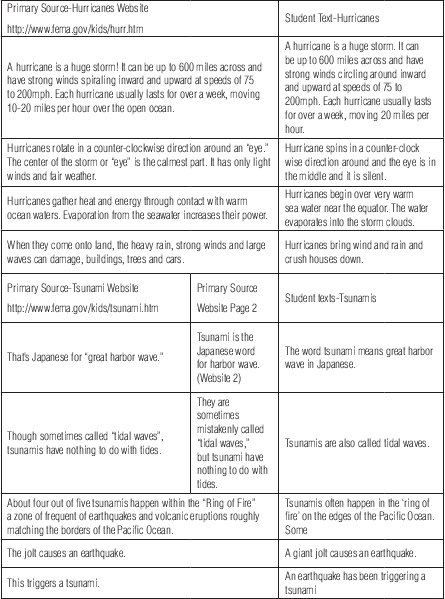
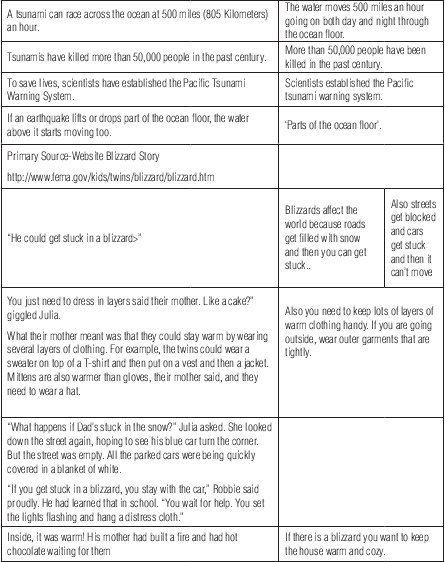
THE AUTHORS
Joshua Schulze is doctoral student in the Language, Literacy, and Culture program at the University of Massachusetts, Amherst . He holds a MA in Teaching Languages from the University of Southern Mississippi and BA in English Literature from University of Richmond , Virginia . He is currently an adjunct professor of education and writing at Cambridge College in Springfield , MA. E-mail:josh_jester@yahoo.com
J. Andrés Ramírez is a doctoral Candidate in the School of Education, University of Massachusetts-Amherst. His research interests are theory and Methods in ESL/EFL, Educational Discourses and the teaching and learning of academic language and content to diverse students, Critical Discourse Analysis and Critical Literacy. E-mail: jaramirez1971@yahoo.com
Creation date:
Metrics
License
This work is licensed under a Creative Commons Attribution-NonCommercial-NoDerivatives 4.0 International License.
Attribution — You must give appropriate credit, provide a link to the license, and indicate if changes were made. You may do so in any reasonable manner, but not in any way that suggests the licensor endorses you or your use.
NonCommercial — You may not use the material for commercial purposes.
NoDerivatives — If you remix, transform, or build upon the material, you may not distribute the modified material.
The journal allow the author(s) to hold the copyright without restrictions. Also, The Colombian Apllied Linguistics Journal will allow the author(s) to retain publishing rights without restrictions.

